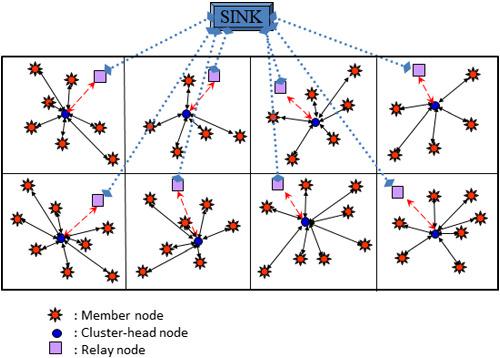当前位置:
X-MOL 学术
›
Int. J. Commun. Syst.
›
论文详情
Our official English website, www.x-mol.net, welcomes your
feedback! (Note: you will need to create a separate account there.)
A two-level clustering mechanism for energy enhancement in Internet-of-Things-based wireless sensor networks
International Journal of Communication Systems ( IF 1.7 ) Pub Date : 2021-07-04 , DOI: 10.1002/dac.4913 Haythem Bany Salameh 1, 2 , Heba Obaidat 2 , Ahmad Al‐Shamali 2 , Yaser Jararweh 3
International Journal of Communication Systems ( IF 1.7 ) Pub Date : 2021-07-04 , DOI: 10.1002/dac.4913 Haythem Bany Salameh 1, 2 , Heba Obaidat 2 , Ahmad Al‐Shamali 2 , Yaser Jararweh 3
Affiliation

|
Wireless sensors are considered the key elements in enabling efficient Internet of Things (IoT) networking and services. One of the key objectives in designing a WSN is increasing network lifetime by reducing the overall network energy consumption. To achieve this, several techniques have been proposed to extend the network lifetime, such as clustering. Clustering divides the network into several clusters, each with its own member nodes and a cluster-head (CH) node. In this paper, a novel clustering mechanism is developed with the objective of extending network lifetime through load balancing in wireless sensor networks (WSNs). This is achieved by electing a new node to a provides specific tasks in the WSN to decrease energy consumption and enhance network lifetime. This node is called a relay node that is responsible of delivering the received data packets from the CHs, and then forwards them to the central node (sink). Unlike previous clustering schemes, the proposed algorithm consists of three main processes: CH selection, relay node selection, and medium access control processes. These processes depend on energy level and user's distributions. The performance of the proposed algorithm is investigated through simulation experiments in terms of network lifetime under various network parameters. The results reveal that the proposed mechanism significantly enhances network lifetime compared to previously proposed algorithms.
中文翻译:

基于物联网的无线传感器网络能量增强的两级聚类机制
无线传感器被认为是实现高效物联网 (IoT) 网络和服务的关键要素。设计 WSN 的关键目标之一是通过降低整体网络能耗来延长网络寿命。为了实现这一点,已经提出了几种技术来延长网络寿命,例如聚类。集群将网络分成几个集群,每个集群都有自己的成员节点和一个簇头 (CH) 节点。在本文中,开发了一种新颖的聚类机制,目的是通过无线传感器网络 (WSN) 中的负载平衡来延长网络寿命。这是通过为 WSN 中的特定任务选择一个新节点来实现的,以降低能耗并提高网络寿命。该节点称为中继节点,负责将接收到的来自 CH 的数据包进行传递,然后转发到中心节点(sink)。与以前的聚类方案不同,所提出的算法由三个主要过程组成:CH 选择、中继节点选择和媒体访问控制过程。这些过程取决于能量水平和用户分布。通过在各种网络参数下的网络寿命方面的仿真实验,研究了所提出算法的性能。结果表明,与先前提出的算法相比,所提出的机制显着提高了网络寿命。中继节点选择和媒体访问控制过程。这些过程取决于能量水平和用户分布。通过在各种网络参数下的网络寿命方面的仿真实验,研究了所提出算法的性能。结果表明,与先前提出的算法相比,所提出的机制显着提高了网络寿命。中继节点选择和媒体访问控制过程。这些过程取决于能量水平和用户分布。通过在各种网络参数下的网络寿命方面的仿真实验,研究了所提出算法的性能。结果表明,与先前提出的算法相比,所提出的机制显着提高了网络寿命。
更新日期:2021-08-04
中文翻译:

基于物联网的无线传感器网络能量增强的两级聚类机制
无线传感器被认为是实现高效物联网 (IoT) 网络和服务的关键要素。设计 WSN 的关键目标之一是通过降低整体网络能耗来延长网络寿命。为了实现这一点,已经提出了几种技术来延长网络寿命,例如聚类。集群将网络分成几个集群,每个集群都有自己的成员节点和一个簇头 (CH) 节点。在本文中,开发了一种新颖的聚类机制,目的是通过无线传感器网络 (WSN) 中的负载平衡来延长网络寿命。这是通过为 WSN 中的特定任务选择一个新节点来实现的,以降低能耗并提高网络寿命。该节点称为中继节点,负责将接收到的来自 CH 的数据包进行传递,然后转发到中心节点(sink)。与以前的聚类方案不同,所提出的算法由三个主要过程组成:CH 选择、中继节点选择和媒体访问控制过程。这些过程取决于能量水平和用户分布。通过在各种网络参数下的网络寿命方面的仿真实验,研究了所提出算法的性能。结果表明,与先前提出的算法相比,所提出的机制显着提高了网络寿命。中继节点选择和媒体访问控制过程。这些过程取决于能量水平和用户分布。通过在各种网络参数下的网络寿命方面的仿真实验,研究了所提出算法的性能。结果表明,与先前提出的算法相比,所提出的机制显着提高了网络寿命。中继节点选择和媒体访问控制过程。这些过程取决于能量水平和用户分布。通过在各种网络参数下的网络寿命方面的仿真实验,研究了所提出算法的性能。结果表明,与先前提出的算法相比,所提出的机制显着提高了网络寿命。







































 京公网安备 11010802027423号
京公网安备 11010802027423号